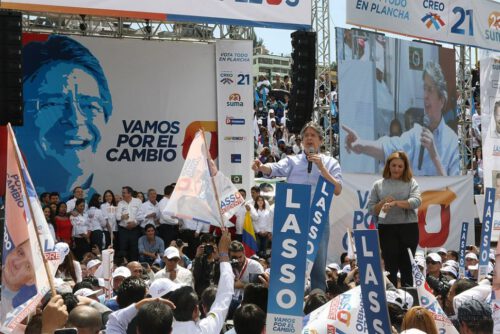Article
Holding Companies Linked to Ecuadorian Presidential Candidate Own 144 Florida Properties Valued at More Than $30 Million

Article
Fact-based, data-driven research and analysis to advance democratic debate on vital issues shaping people’s lives.
Center for Economic and Policy Research
1611 Connecticut Ave. NW
Suite 400
Washington, DC 20009
Tel: 202-293-5380
Fax: 202-588-1356
https://cepr.net
Last week, I went through public documentation that indicates Ecuadorian presidential candidate Guillermo Lasso, despite “retiring” from banking in 2012, continues to be the largest shareholder in Banco Guayaquil. There is also public documentation — not to mention Lasso’s own admission — that he and his family are owners of a bank in Panama, Banisi. In 2014, Ecuador passed new regulations preventing banks from having subsidiaries in tax havens, potentially putting Lasso and his family in violation of the law.
Lasso has not addressed the allegations in depth, but has acknowledged that his family owns the Panamanian bank while also declaring that all his assets are public and in Ecuador. Moving past the obvious contradictory nature of such statements (if you own a bank in Panama, it’s pretty clear that not all your assets are in Ecuador), new revelations this week from Cynthia Garcia of Argentina’s Página/12 indicate that Lasso and his associates likely have significant offshore holdings in addition to those located in the Panamanian bank, particularly in the state of Florida — known for its lax corporate oversight and as an ideal spot for foreigners to park their dollars. Prompted by Garcia’s reporting, I again looked into the public record to see what was there.
In 2009, according to the Florida Division of Corporations, Guillermo E. Lasso — the candidate’s son — registered an LLC in Florida called Nora Investment US. From June 2009 to December 2010, the holding company purchased 59 properties, which it still owns today, in Florida’s Broward County according to publicly available records. The purchases, mostly condos, totaled $5.7 million.
But this was just the beginning. In 2011, two new directors were added to Nora Investment US: Miguel Macias and Euvenia Touriz. Both were previously officials at Banco Guayaquil, and both are currently listed as directors at the Banisi bank in Panama that is owned by Lasso. From 2011 to 2013, Lasso (the candidate’s son), Macias, and Touriz registered 10 LLCs in Florida in which they are all listed as directors. The additional LLCs were also used to purchase properties in Florida.
In August 2014, following Ecuador’s implementation of new regulations concerning offshore assets, Lasso’s son’s name was systematically removed as a director from all 10 companies, the public records show. But Macias and Touriz continued to open additional holding companies. It is important to note that while LLCs list directors, the so-called beneficial owner — or true owner — is concealed.
The proliferation of new holding companies continued, however. There are currently 28 different holding companies registered in Florida that list Macias and Touriz as directors — as a simple search here shows. Far from just past practice, the public record shows the two Lasso associates registering a new company as recently as January 2017 ? just a few months ago and in the height of the presidential campaign.
Together, the 28 holding companies are owners of Florida properties with an assessed market value of $31.2 million — likely an undervaluation. With the exception of two million dollar commercial properties each purchased in April 2016, there is no public record of any mortgages being taken out by the holding companies, indicating that the purchases were likely made with cash.
Most of the properties purchased appear to be multiple units within larger real estate developments. For example, on just one day in February 2012, one LLC, Nora Investment Tres US, purchased 19 homes in Lauderdale Lakes, Florida, totaling $2.6 million. On April 15, 2011, another company, Nora Investment Uno US, purchased 14 properties in Doral, Florida for a total of $3.2 million.
However, in more recent years, the real estate purchases shifted from lower cost units to high-end luxury apartments in Miami. From July 2013 through October 2015, nine different holding companies purchased a total of 14 apartments in Miami — many of which are in the same building complex, the Asia Brickell Key Miami. The average purchase price of these 14 properties was $1.2 million, and there appears to be no record of any mortgage being taken out for any of the purchases. The most expensive of the luxury condos, purchased for $1.7 million in March 2014, can be seen in this real estate company’s promotional video.
The most recent real estate purchase by one of these Lasso-affiliated LLCs was made in July 2016, according to publicly available records.
To be clear, there is no documentation of who the real owners of these 28 Florida-registered LLCs actually are. However, the presence of Guillermo Lasso’s son on the initial registration documents, and the ongoing presence of two directors of Lasso’s Panamanian bank on all 28 LLCs, certainly raises significant questions about the 144 properties they currently own in Florida, and to what extent the Lasso family has used offshore tax havens and LLCs to hide its wealth. (In 2012, Ecuador recognized the US states of Florida, Wyoming, Nevada and Delaware as “tax havens.” In 2015 Ecuador removed the four states from its list of tax havens, but introduced the concept of low tax jurisdictions which are handled on a case-by-case basis.)
It’s worth noting that alongside this February’s first-round presidential elections, Ecuadorians approved a ballot initiative barring politicians in the country from having bank accounts or companies in tax havens.